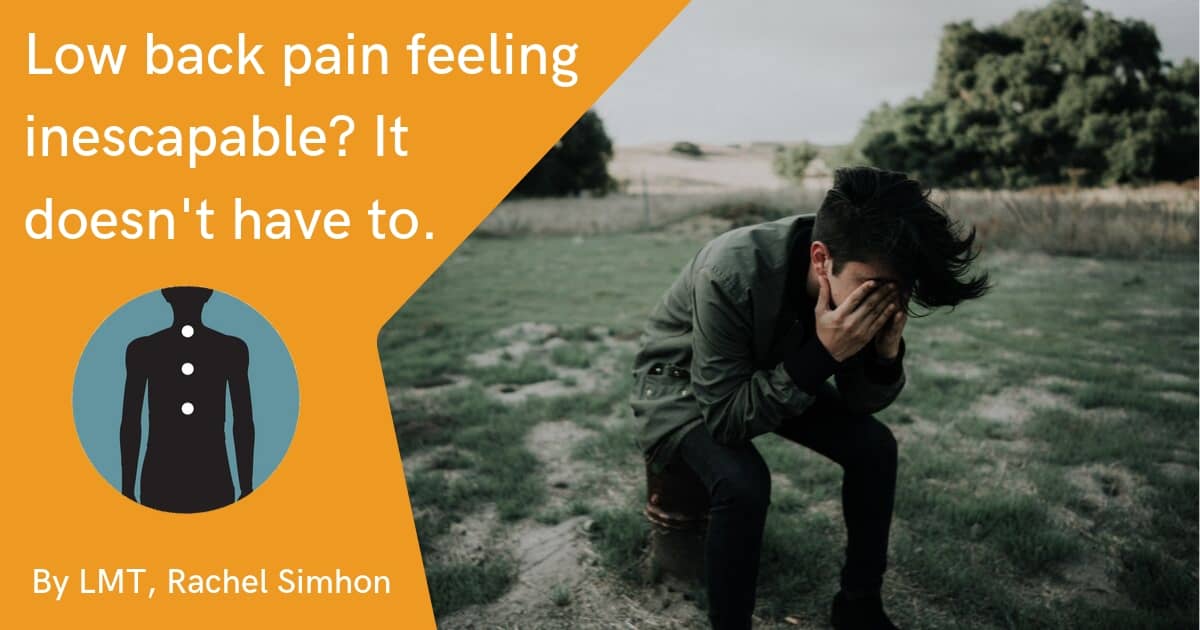Can massage therapy help with low back pain in the long term?

Rachel Simhon, LMT provides all the information you need to know about the back pain you’re experiencing. Turns out, it doesn’t need to be permanent!
Low back pain: a common complaint
One of the most frequent complaints we hear about from our clients is low back pain. Some clients present with episodes of pain that are acute, which means they came on suddenly. Others describe pain that is chronic: it’s been there on and off for months or even years. And they may go so far as to identify with the pain, i.e. “I’ve got a bad back.” Either way, it can be debilitating and prevent you from fully enjoying life.
How and why does low back pain happen?
Low back pain can range from a dull ache and tightness to sharp spasms that make movement next to impossible. You might recall a specific incident, like the time you hoisted a heavy suitcase into a taxi after a flight. Or you are not quite sure how or when the pain came on. Sometimes clients come to us with a diagnosis and imaging from a physician. And a medical history that may even include surgical interventions for structural conditions of the spine. More often than not, however, your pain is unknown in cause.
A costly public health issue
The World Health Organization reported in 2011 that 8 out of 10 American adults experience low back pain at some point in their lives. The consequences of this go far past the individual sufferers. Low back pain is the second most common cause of disability in adults in the US. It’s also the number one cause of missed work days worldwide. And Americans spend approximately $50 billion every year in medical expenses related to back issues!
Contributing factors to Low Back Pain: Not necessarily a structural issue
Low back pain is obviously a serious problem. But how can massage therapy help? Sometimes pain is related to structural damage to the spine or its surrounding structures. If so, you may really need surgical intervention. However these cases are fairly rare. The overwhelming majority of cases can’t be tied to a specific diagnosis or structural issue.
Research suggests that a majority of adults have structural damage from acute injuries or degeneration but don’t have any symptoms. Therefore, it’s difficult to establish a cause-and-effect relationship between a bulging disc, for example, and severe back pain. Or prevents you from playing with your children.
Common Roots of Low Back Pain
Many of the factors associated with low back pain have to do with your lifestyle and/or habits. As a result, treatments that work long term involve making changes to your habits that could be causing the issue. Here are a few typical factors related to developing low back pain. And how the work we massage therapists do at Bodyworks DW can help address them:
Sedentary lifestyle
Lack of regular movement increases risk for not only the development of pain, but also its severity. Not moving enough has been associated with everything from poor circulation to adhesions in connective tissues and joint capsules. Not to mention weakness in the muscles that help support the spine. Something I hear very often from clients is that they would like to exercise and be more active. But they’re in too much pain. Dr. Ida Rolf, one of the founders of myofascial release techniques, described pain as “sensation accompanied by the motor intention to withdraw.” Something hurts, you don’t want to or are afraid to move, it hurts more, and the cycle continues.
Massage therapy can help relieve your pain and increase your range of motion in joints. This can decrease your fear of movement allowing you to re-engage in exercise. It can be used to minimize delayed onset muscle soreness and help keep you active once you are regularly moving again. At Bodyworks DW we also recommend exercises you can do at home to make the session even more valuable. And, if we think it will help, refer you to movement professionals. These may include Pilates instructors, personal trainers, and strength coaches who can help you start a regular exercise program.
Excess weight
Excess weight can put strain on your spine. While massage therapy isn’t specifically a weight loss tool, it can help bring about relief. And since weight gain also frequently results from sedentary lifestyle, massage therapy can help remove barriers to getting regular exercise. For nutritional support, we can also refer you to a registered dietician who can assist with changes in your diet.
Poor posture
Any posture held for a prolonged period can place excessive pressure on the joints, muscles, and discs, eventually causing pain. But sitting for long periods of time can be especially problematic in contributing to low back pain. Sitting for long periods constricts the hip muscles limiting range of motion.
After a while you can lose the necessary range of motion in your hip joints to stack your spine over the base of your pelvis. In order to sit up straight, you then have to over-engage your low back muscles. This pattern is something I encounter in several clients a week. Deep tissue massage on your pelvic muscles at the hip joint can relieve tension that contributes to low back pain. And help you sit without strain. For homework, I often recommend self-release of the hip flexors in the abdomen using an inflatable ball (https://www.youtube.com/watch?v=hU5kqpTbynk) and exercises to help mobilize the hip joint (https://www.youtube.com/watch?v=GImwCsuBLyo).
Stress and other psychological conditions
When you are stressed or anxious, your breathing patterns change. Your body prepares for action (fight or flight) by sending out hormones such as adrenaline and cortisol. Your muscles tense to either fight or run, which is important for survival.
Or at least it used to be. Back when our systems evolved and the things that stressed us were planning on eating us. Unfortunately, our body still equates stress to being chased by a tiger. And our systems are designed to deal with that instead of that report that is due by Monday. It would be far healthier if you could sprint down the block every time your boss yelled at you. However, you usually can’t take big physical action to help respond to the source of stress. And just have to sit at your desk and type.
“Stress changes our breathing and posture”
All that hyped-up tension to act builds up in our muscles over time. Going to the gym can help a little bit but not as much as you would like. Our stress response systems are really designed to be used immediately, not 6-8 hours later. By the time you get to the gym your body actually wants to be resting and digesting. And often you end up denying it that as well.
Relearning how to breathe naturally can help downregulate your constant fight-or-flight response. Some of the work that we do together is to relieve tension in your accessory breathing muscles. So that you can take a smooth and easy breath. After the session, I’ll always give you breathing exercises to do at home. To promote learning how to drop flight or fight and engage rest and digest systems: https://www.otpbooks.com/kathy-dooley-breathing-core-control/
Muscle imbalances
Different muscles support your trunk and help stack your spine. The length and strength of the muscles surrounding your vertebrae both need to be in balance. I often tell my clients that a building doesn’t remain upright simply because we’ve poured lots of cement on it. It stays up due to the placement of the materials being structurally sound and in balance. The human body is no different in this respect.
Activities such as sitting at a desk all day or even overly strenuous exercise can result in muscle imbalances. An imbalance means that the muscles on one side of your body, for example, may be overactive. While the ones on the other side are weak. These discrepancies can pull the body out of structural alignment. And put strain on the spine and lead to pain.
Sitting for prolonged periods leads to tension in the hip flexors. And weakness of the hip extensors and abdominals. Which makes it difficult to go from sitting to standing. And walking up stairs without strain in the lower back.
With my clients, I do a thorough postural and movement assessment, along with manual muscle testing. This allows me to determine what to focus on during the session to relieve the root of your problem. I follow this up with recommendations for at-home exercises: https://tonygentilcore.com/2016/03/6-unconventionally-simple-exercises/.
How we work on low back pain at Bodyworks DW
Low back pain is one of the most frequent concerns from our clients at Bodyworks DW. So the therapists on staff have considerable experience working to relieve it. We are asked daily to help address it effectively and keep it from becoming a chronic issue. Our low back pain-focused sessions include assessments to identify postural and movement dysfunctions that might be causing your pain.
We also work with you to develop a treatment plan. That includes the number and frequency of follow up sessions we believe would be beneficial. And at-home exercises and lifestyle recommendations to help keep you pain-free in the long term. Curious about back pain massage in New York City? Contact Bodyworks DW today or click on the button to book online at either our back pain massage Financial District or back pain massage Midtown Manhattan locations!


Pingback: Can massage therapy help with low back pain in the long term? – Bodyworks DW